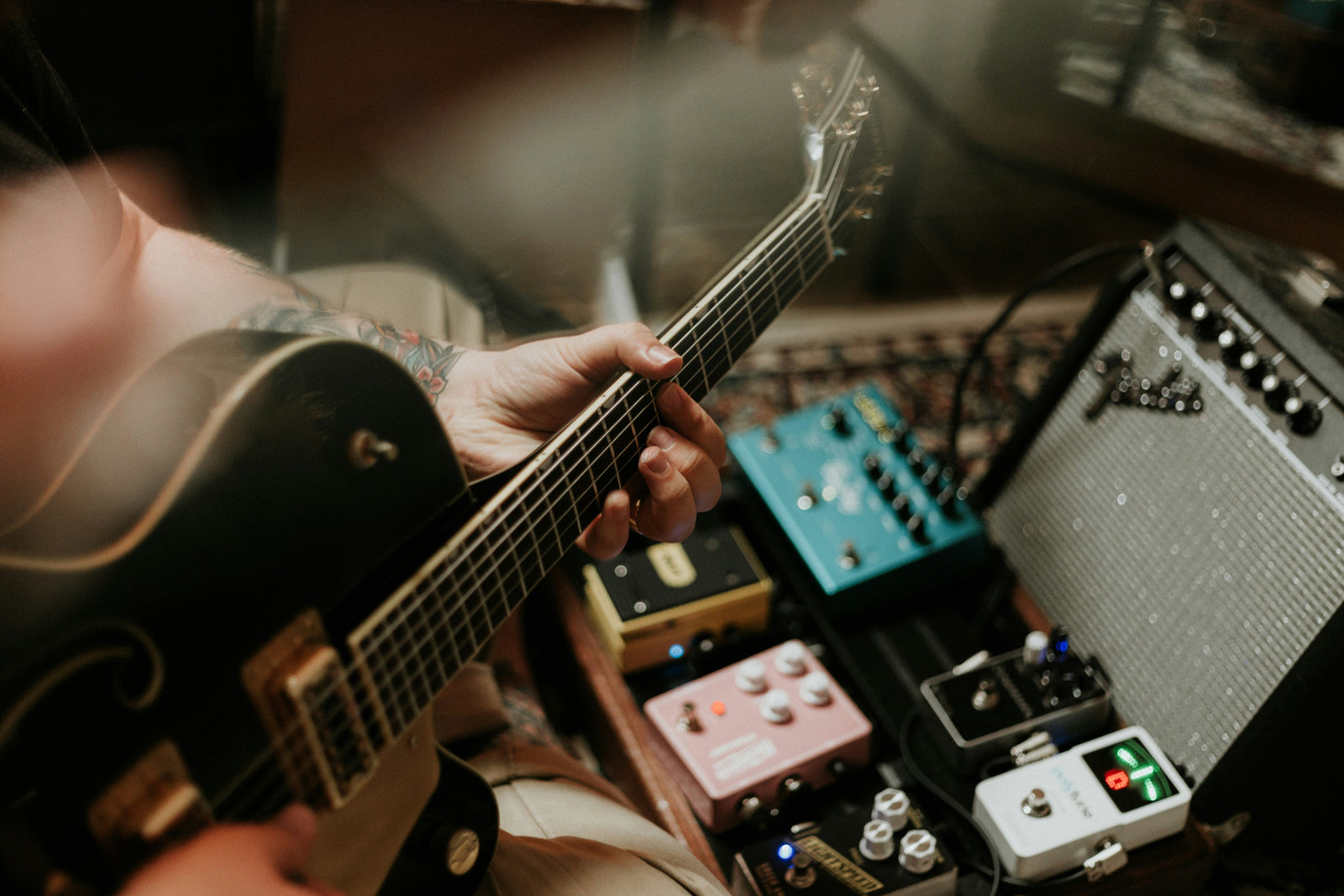Guitar Tuner Soundhole Overview
Welcome to the world of soundhole guitar tuners. This type of tuner is a boon for guitarists seeking precision. It fits into the guitar's soundhole. This placement makes it ideal for quick tuning checks during performances.
Unlike headstock tuners, soundhole tuners are less visible. They provide a clear, unobstructed view of tuning status. This discreet positioning makes them popular among performers.
Soundhole tuners work by detecting the vibrations uninterrupted. This direct detection leads to quicker and more accurate tuning. Their design also protects the aesthetic integrity of the instrument.
Whether practicing at home or performing live, soundhole tuners add value. They excellently blend with the guitar, enhancing both function and form.
How Does a Guitar Tuner Soundhole Work?
Understanding how a soundhole tuner operates is key to utilizing its benefits. Manufacturers design these tuners to fit within the soundhole of an acoustic guitar. Here, they use the natural acoustics of the instrument to assist in tuning.
Attachment Methods
Attaching a soundhole tuner is straightforward and non-invasive. The tuner clips in a tight manner onto the edges of the soundhole. This design ensures it does not interfere with the strings or the guitar’s surface.
Many models use soft, protective materials to prevent damage to the guitar's finish. The placement is also strategic to keep the tuner discreet yet accessible.
Sound Detection
Once attached, the tuner picks up sound vibrations straight from the soundboard. This proximity to the source of sound allows for rapid and precise detection of pitch.
Some soundhole tuners use piezo sensors. These are sensitive to vibrations rather than airborne sound. This technology makes them efficient in noisy environments. It also means they can offer more stability in tuning. This contrasts with external microphones or electric tuners that clip to the headstock.
The tuner displays the current tuning status. Usually through a clear, easy-to-read digital interface. LED indicators are common, providing visibility even in low-light conditions.
Advantages of Using a Guitar Tuner Soundhole
The advantages of using a guitar tuner soundhole are significant. Particularly for musicians who need reliable and swift tuning during performances or recordings.
Accuracy and Speed
Soundhole tuners provide precise tuning by straightforward contacting the guitar's vibrations. This method reduces errors from background noise, ensuring quick and precise tuning.
Musicians can adjust their guitars with ease, crucial for smooth performances or recordings.
Convenience for Performers
These tuners enhance performer convenience. Placed within the guitar's soundhole, they remain visible to the performer. This doesn't disrupt audience engagement. Their compact design does not affect the guitar’s balance or handling. It aids in performance comfort.
Overall, soundhole tuners are tailored for performers, simplifying tuning during live shows or studio sessions. They help musicians maintain perfect pitch, allowing them to focus on their performance rather than equipment.
Types and Models of Guitar Tuner Soundhole
Here are the key types of soundhole tuners. Each defines its respective pitch detection technologies:
-
Clip-on Soundhole Tuners
These tuners attach straight to the soundhole using a clip. It features piezo sensors to detect vibrations from the guitar body. This setup ensures accuracy as it minimizes interference from ambient noise. The design also includes rubber pads to protect the guitar's finish.
-
Rotating Display Tuners
Equipped with adjustable screens. Users can rotate these tuners to provide optimal viewing angles. They often use piezo sensors and digital signal processing (DSP) to enhance accuracy. Ideal for performers who need to check tuning without adjusting their posture.
-
LED Display Tuners
These tuners use bright and clear LED displays. It makes it easy to read in various lighting conditions. They usually use piezo sensors for accurate pitch detection. Ensuring that the tuner provides precise feedback even in noisy environments.
Each type offers unique features that cater to different preferences and performance environments. Ensuring guitarists can find a tuner that matches their specific needs.
The technology used for detecting pitch in soundhole tuners often involves the following:
1. Piezo Sensors: These sensors detect vibrations straight from the guitar's body. This method reduces ambient noise interference, making them ideal for noisy settings.
2. Microphone-Based Sensors: These sensors pick up sound through microphones. They are sensitive to background noise but capture a broad frequency range.
3. Digital Signal Processing (DSP): DSP enhances tuning accuracy by processing audio numerical signals. This technology is especially useful in complex acoustic environments.
Each technology caters to different needs. With piezo sensors being particularly reliable for live performances.
Guitar Tuner Soundhole Brand: KORG
KORG stands out for its innovative music technology, including guitar soundhole tuners.
Their products, like the popular KORG Rimpitch, offer precision and ease. These tuners fit inside the soundhole for quick, unobtrusive tuning. They're designed for accurate, reliable tuning, crucial during live performances.
KORG tuners are easy to tweak, making them suitable for all skill levels. They also focus on durability and portability, ideal for touring musicians.
Top KORG Guitar Tuner Soundhole: Rimpitch-C2
The KORG Rimpitch-C2 is a top choice for guitarists who value discreet tuning.
Here’s a concise overview of this tuner:
- Design and Installation: The Rimpitch-C2's ultra-slim design fits inside the guitar's soundhole. This placement keeps it hidden from the audience.
- Operation and Visibility: The tuner's meter is visible within the guitarist's natural line of sight. This setup lets musicians track tuning without a break in performance. The clear LED display is especially helpful in both bright and dim lighting.
- Accuracy and Versatility: Equipped with a piezo pickup. The Rimpitch-C2 attaches to the guitar's body for fast and accurate sound detection. This feature is crucial for quick tuning adjustments during live shows.
Key Features:
- Rubber cushions on the tuner ensure it stays in place and protects the guitar.
- The tuner fits round soundholes around 100 mm in diameter. Suiting various acoustic guitars.
- It offers adjustable concert pitches from 438 to 445 Hz. It accommodates different musical styles.
The Rimpitch-C2 covers essential frequencies from E2 (82.41 Hz) to E7 (2637.02 Hz). When tuning is exact, the LEDs blink to provide immediate visual confirmation.
Features to Look For in a Guitar Tuner Soundhole
Choosing the right soundhole tuner involves considering these features. It helps find a model that suits your performance style, guitar type, and budget.
This ensures you get a tuner that not only works well but also enhances your playing experience.
1. Ease of Installation
Look for tuners that are easy to attach and remove without tools. This feature is especially useful for musicians who switch between instruments.
2. Display Quality
A clear, readable display is crucial. Choose models with bright LED or LCD screens visible in various lighting conditions. This ensures optimal visibility during use.
3. Tuning Accuracy
Precision is vital. Users select tuners known for their reliability and accuracy in pitch detection.
4. Compatibility
Ensure the tuner fits your guitar’s soundhole size. Most manufacturers design them to be universal, but it's best to check.
5. Discreet Design
Many players prefer tuners that are unobtrusive and blend in with the instrument.
6. Battery Life
Long battery life is a plus. Look for tuners with auto-off features to conserve power.
7. Durability
A robust build that can withstand frequent use. Also, the occasional bump is essential for gigging musicians.
8. Vibration Sensing
Tuners with piezo sensors are effective. They pick up vibrations straight from the guitar.
9. Anti-Interference
Good tuners cut interference from ambient noise, ensuring accurate tuning in various environments.
10. Cost-Effectiveness
Balance features with cost. More features might mean a higher price, so consider what you need.
Best Practices for Using Guitar Tuner Soundhole
To maximize the benefits of your guitar tuner soundhole, consider these practical tips:
Using the Tuner Effectively
- Attach the tuner in a secure manner to the soundhole for stable readings.
- Stand still while tuning to ensure accuracy.
- Check the tuner's battery from time to time and replace it before it fails.
- Start tuning in a quiet environment to learn how your tuner responds.
- Ensure the tuner's settings align with your guitar type. Especially for acoustic or classical models.
Maintenance Tips
- Wipe the tuner in a gradual manner with a soft, dry cloth to prevent damage.
- Keep the tuner in a dry area to avoid moisture, which can damage its electronics.
- Protect the tuner from extreme temperatures. Heat can degrade components and cold can cause condensation.
- Examine the tuner’s clips and attachments for wear or damage.
Tuning in Noisy Environments
- In noisy areas, position the guitar so the soundhole—and tuner—point away from the noise.
- Choose a tuner with advanced noise-filtering technology. This is important if you often play in loud settings.
- Practice tuning in diverse environments to find the correct pitch, despite background noise.
These guidelines will help ensure your guitar is always tuned. Proper maintenance and use of the tuner extend its lifespan. Also, it guarantees dependable performance.
Conclusion: Maximizing the Benefit of Guitar Tuner Soundhole
The guitar tuner soundhole represents a significant advancement in tuning technology for guitarists. This innovative tool combines convenience, accuracy, and discretion, enhancing both practice and performance.
Embracing this technology can enhance a musician's confidence and performance quality. For guitarists at any level, the benefits of using a soundhole tuner are clear. They streamline the tuning process and ensure that the guitar sounds its best.
In conclusion, integrating a soundhole tuner into your routine is a smart choice. They are suitable for any guitarist looking to improve their efficiency and performance. With the right tuner, you can focus more on your music and less on the mechanics of your instrument.





